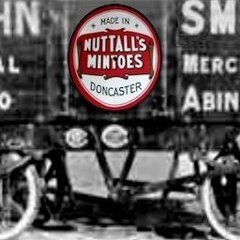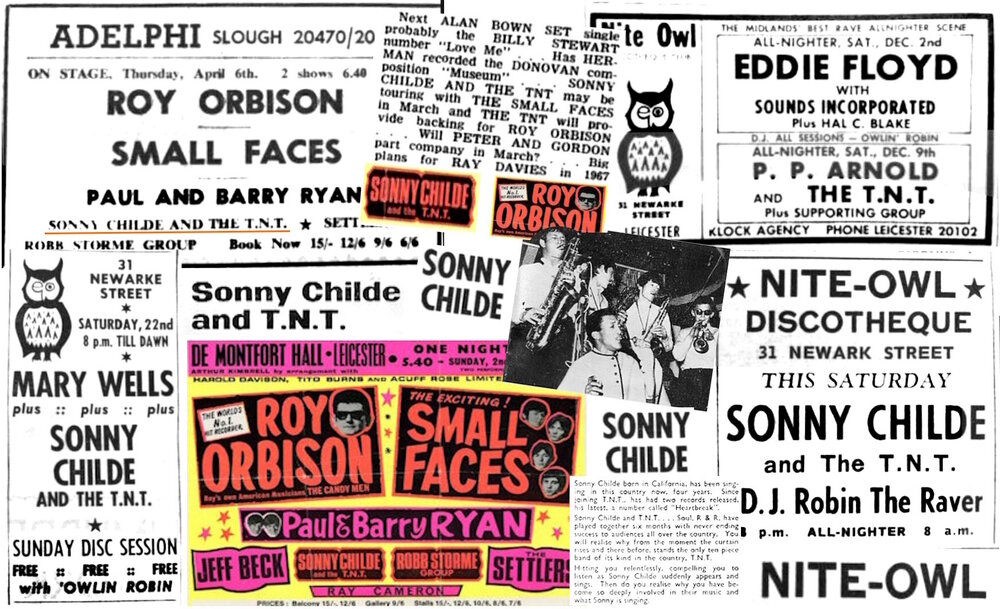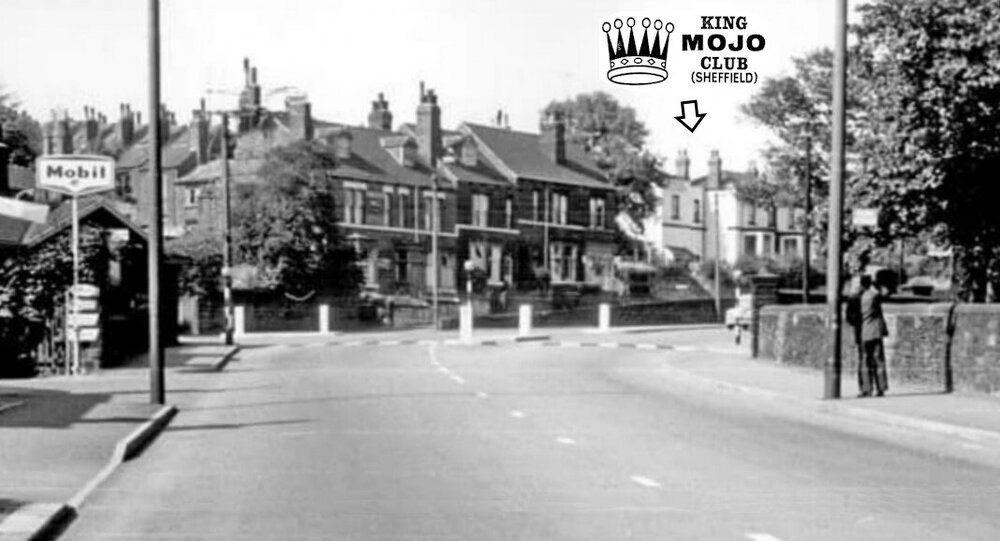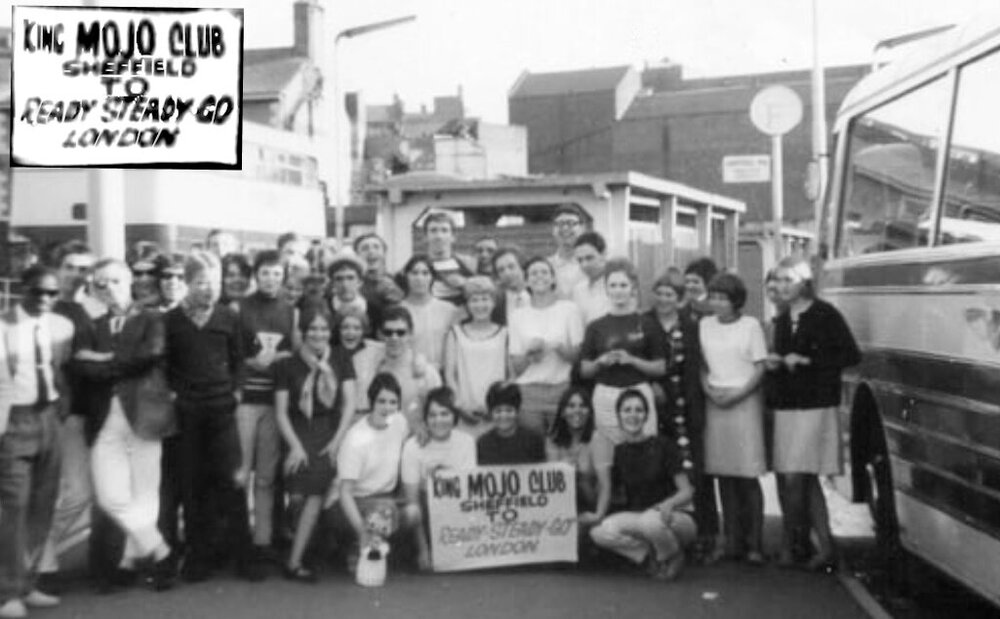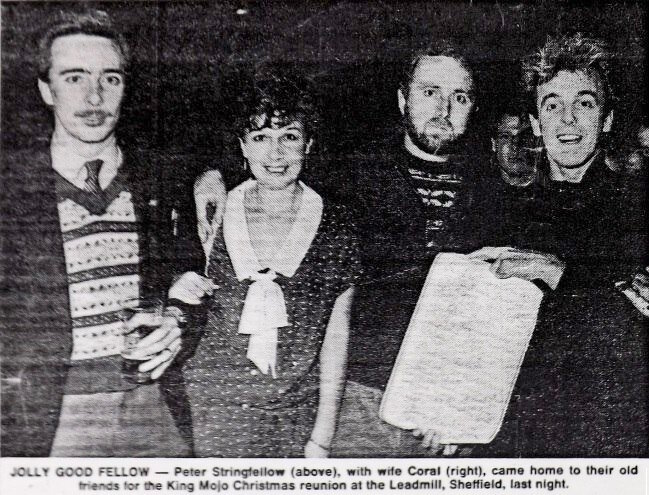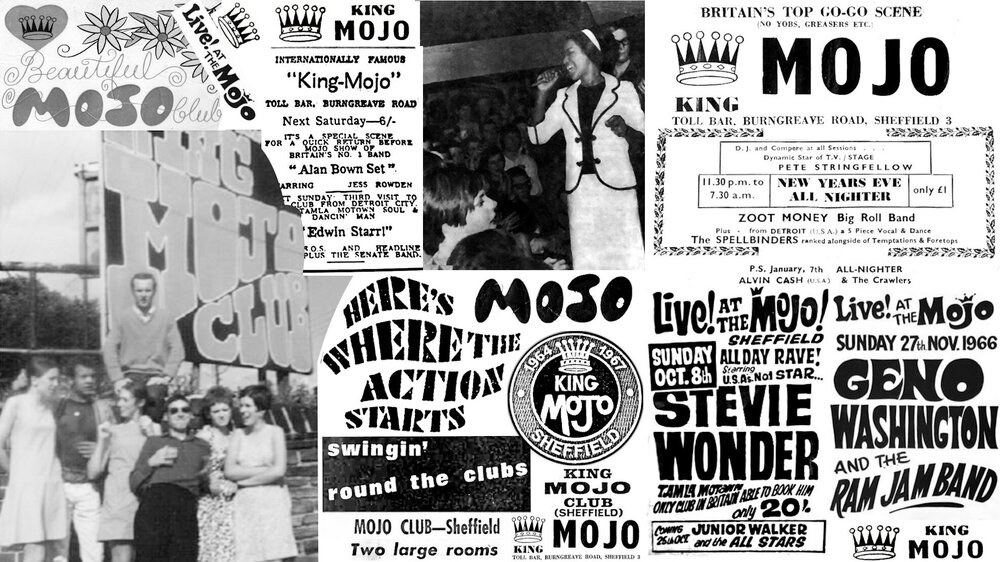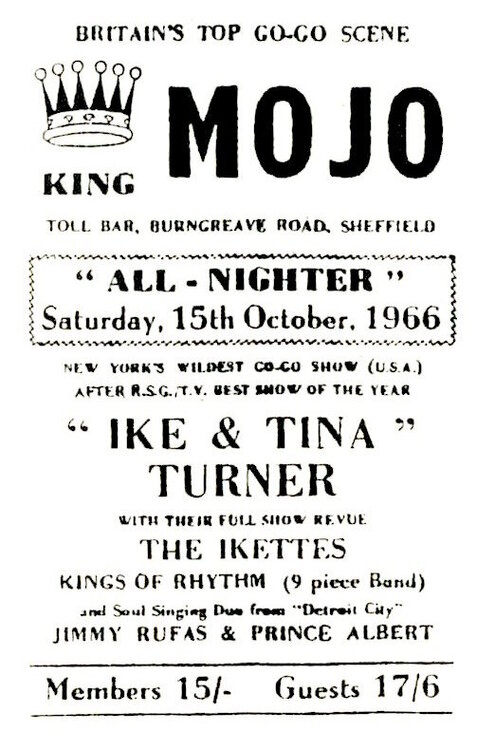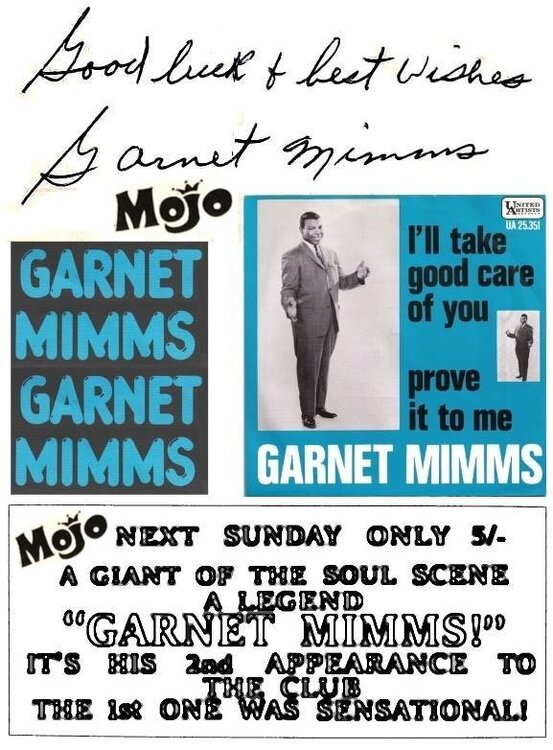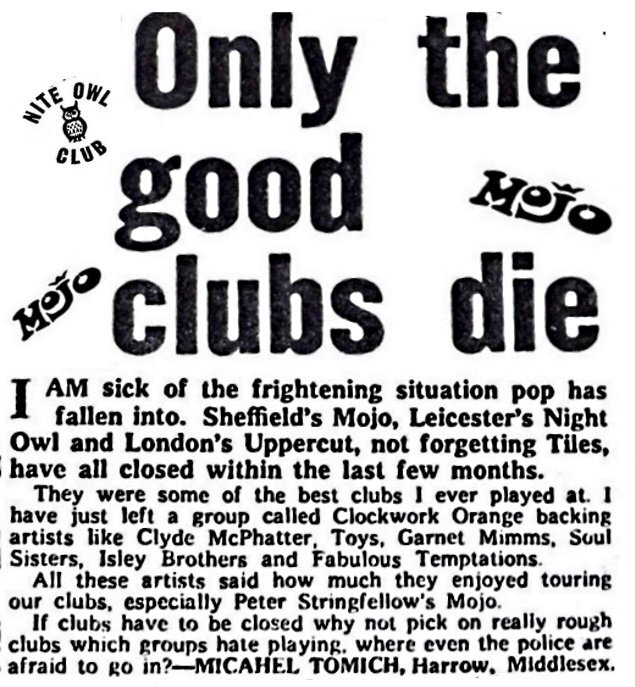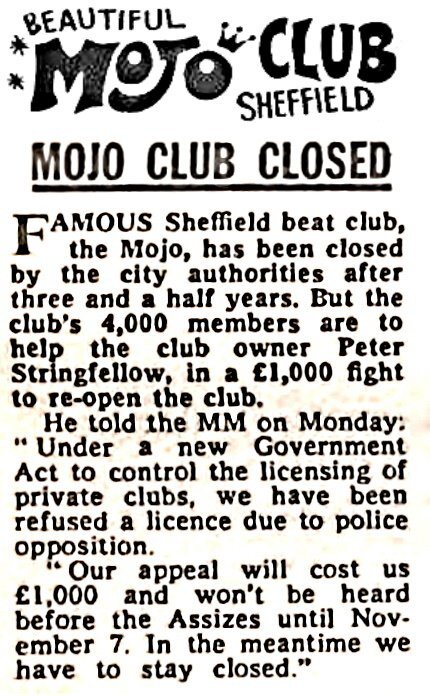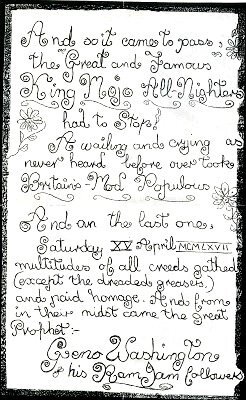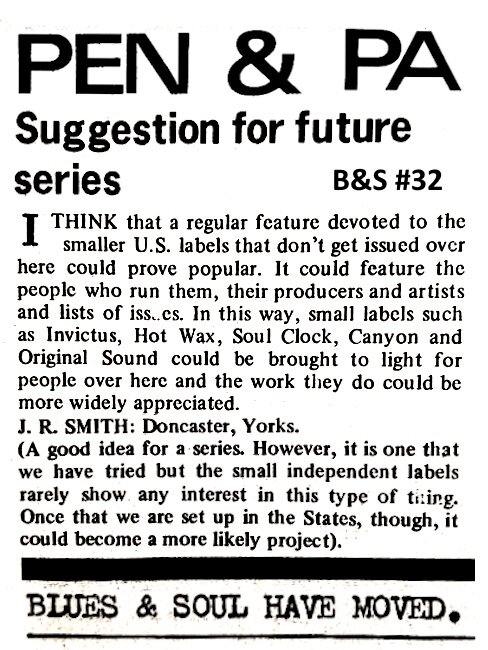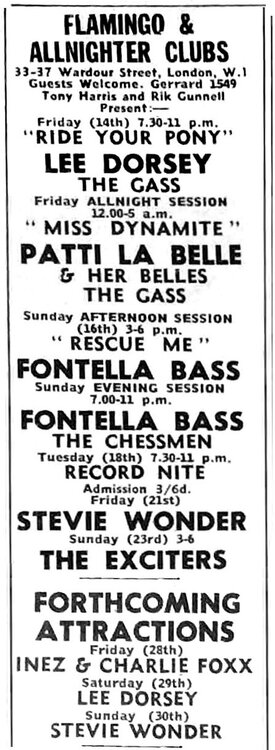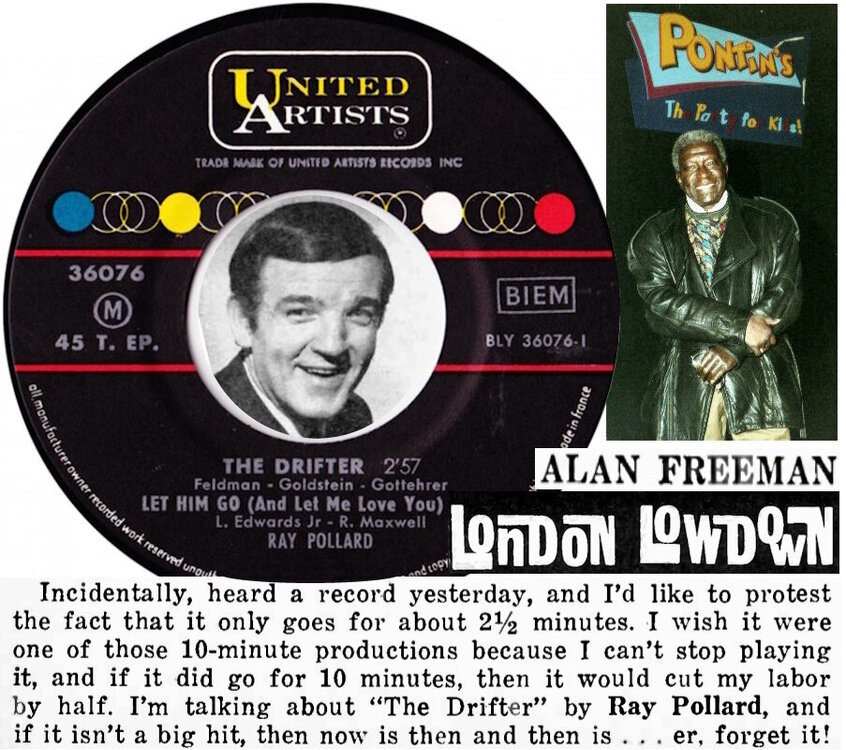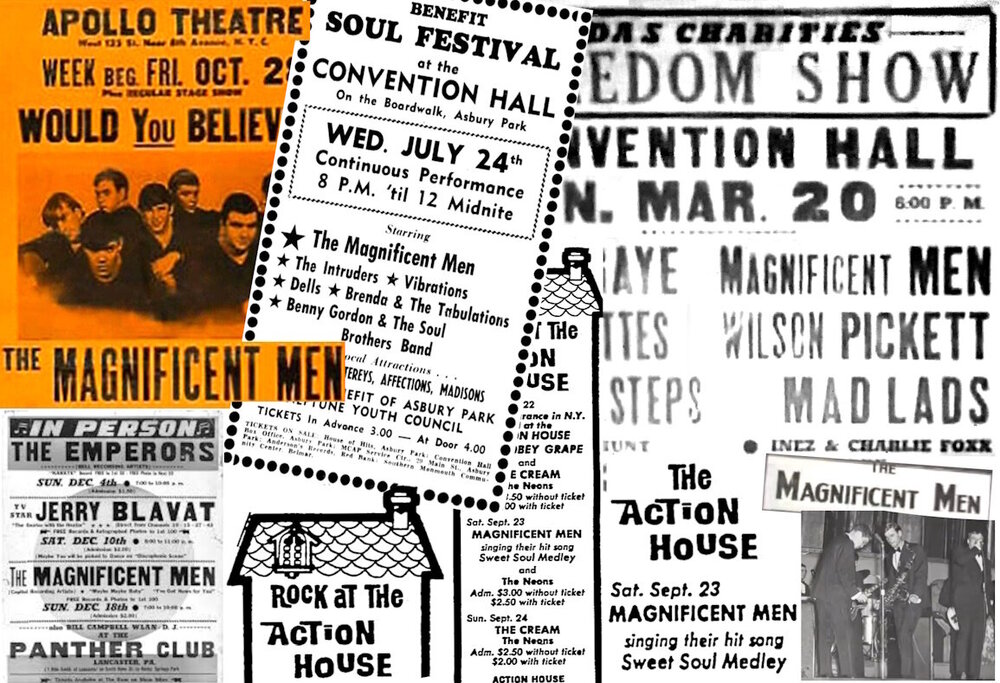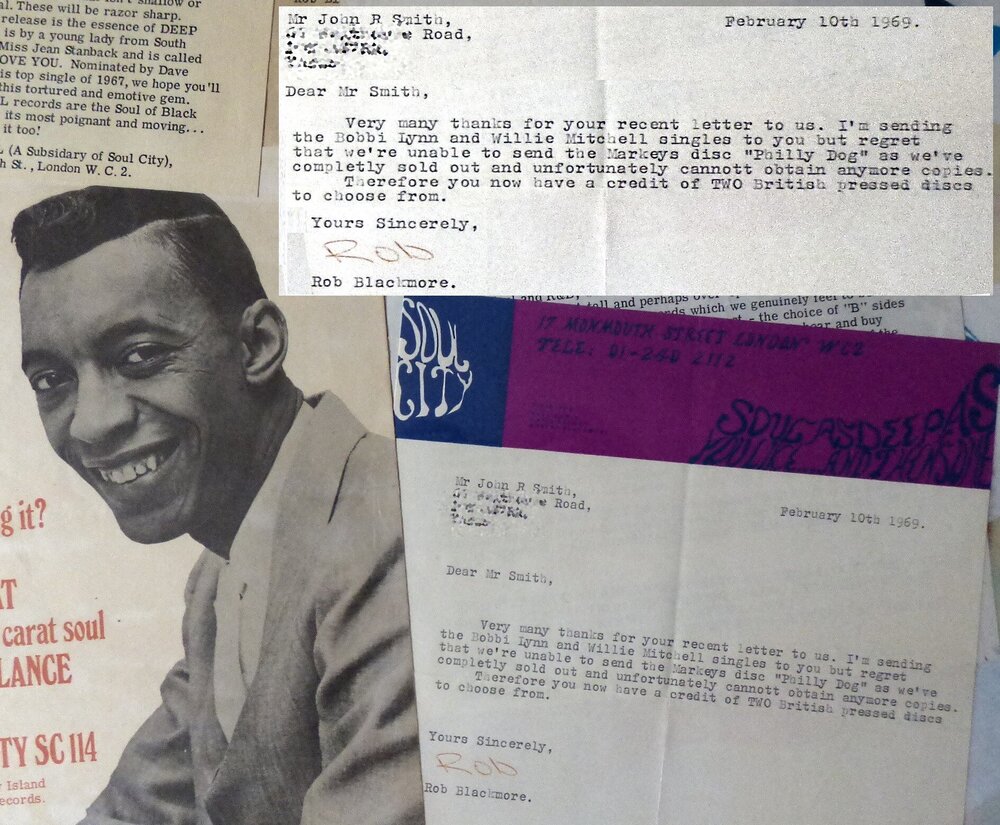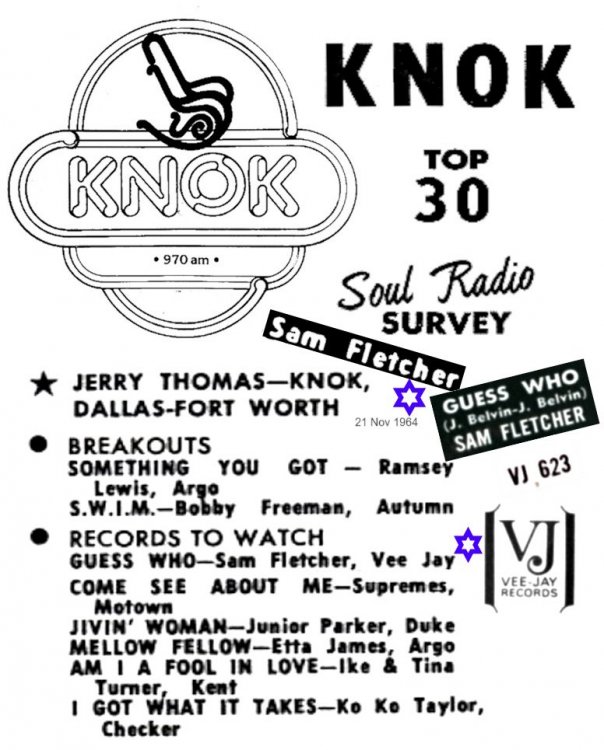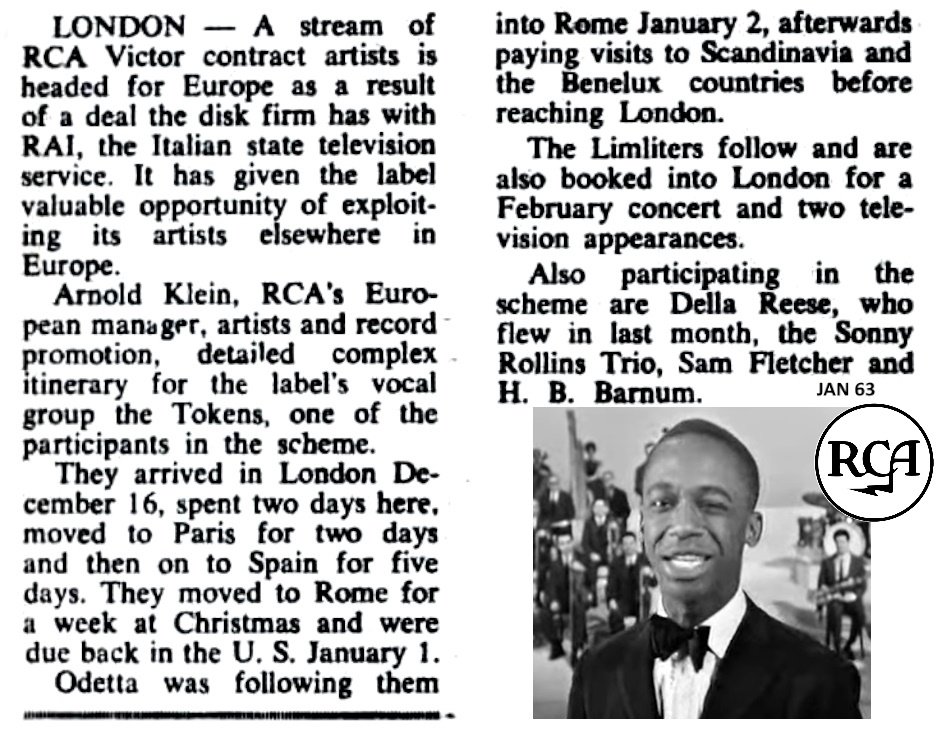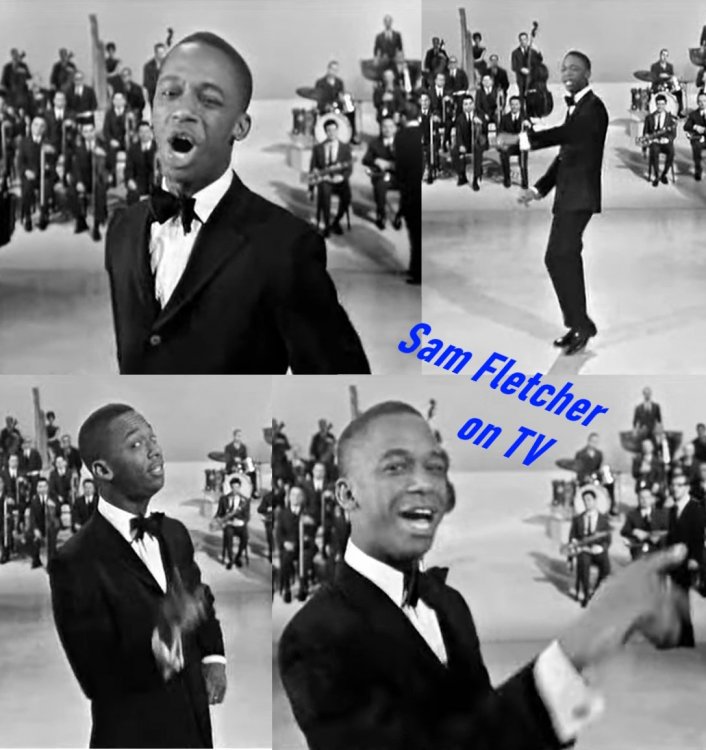Everything posted by Roburt
-
The Mojo Sheffield
A few tracks were popular @ the Mojo coz Pete realised the crowd would sing along with them, but could substitute 'Mojo' in the lyrics instead of the correct ones. Stevie Wonder's "Love A GoGo" was a big tune at the club with us all singing "Love The Mojo" instead of the proper lyrics.
-
Sonny Childe - A Thing Called Love
Sonny Childe had a few backing bands before he teamed with the TNT. Another one was the Cool School. He then teamed with the Sidewinders in early 66. He joined Freddie Mack and his band soon after; This -N- That. He stayed in that position for around 8 to 10 weeks and then went out on his own, taking Freddie's band with him as the TNT. Sonny & the TNT soon established themselves as an exciting live band and got repeat bookings at clubs such as the Beachcomber, Nottingham in summer 66. They went on a big UK tour in March / April 67 with the Small Faces & Roy Orbison. Still in demand in their own right, they got return bookings to play the niter session @ the Nite Owl, Leicester in spring & summer 67. They also played other noted venues such as the Golden Torch & California Ballroom + the top London clubs. In 1966 & 67 the outfit had a recording contract with Polydor. But Sonny split with the TNT in August 67 and the group went on to tour behind P P Arnold in late 67 & 68. Sonny signed with MGM / Music Factory (as did another Pye soul group, the Alan Bown Set). He recorded some tracks but they were only released in the US (in 68) -- so I presume he'd returned to the US by then Sonny Childe was only with Elders Consolidated till summer 65, so that acetate must date from around then I guess.
-
The Mojo Sheffield
An article I wrote about the club around 25 years ago ... Although it is now more than 30 years since the club closed down, the memories of the King Mojo Club in Sheffield are still fresh for the people who used to go there every week. Those memories are stirred every time that news about Peter Stringfellow appears in the press. The club was opened in 1964 by brothers Pete and Geoff. They first made a name for themselves thanks to a booking they made of the Beatles just before the group's initial 45 release took off. The Beatles show was a big success and this resulted in them signing similar bands to appear at their events. They promoted gigs for the Rolling Stones and other British R &B bands. The brothers were then offered an old hall, Day's Dance Hall, and they rented it for £30 a week after refurnishing it. They choose the name Mojo after hearing the song "Got My Mojo Working" and the club soon attracted a new set of people who followed blues and soul music. It quickly earned a great reputation because of the enthusiasm of the two brothers. At the beginning, it only was open on Thursday, Friday and Saturday, but soon an allnighter session was added on Saturdays, just about always with an American soul artist being the live attraction. On Sunday it was time for British R & B or soul bands, the session running from 8pm until 11pm. Sometimes, Pete and Geoff could not afford the money a great artist demanded, acts such as Wilson Pickett, so they asked him to appear at 2am, after he had sung at a bigger club earlier the same evening. The artist always charged them less for doing so (two bookings in one night increasing the profitability of a UK tour). All-nighters began in 1965 with a £1 entrance fee and the sessions commenced at midnight. Soon, a regular crowd began to attend, with people from Sheffield and nearby towns like Doncaster, York, Hull, Scunthorpe, Lincoln and Nottingham turning up. The main meeting point at the start of the night's action was the Favorita Coffee Bar, in the centre of town. At 11pm everybody headed off to the Mojo and began to queue in order to ensure they got an early entry. Of the two brothers, Pete was always the showman and he also liked to DJ. In 1963, ITV had started "Ready, Steady Go", where you could see lots of black artists such as Major Lance, Otis Redding or Inez & Charlie Foxx perform. Pete Stringfellow enjoyed the programme so much that he went to the ITV offices to talk with one of the producers, Vicki Wickham. The show gave Pete the task of entertaining the audience in the studio before filming began and also put him in control of the dance floor. He worked on “Ready, Steady, Go” for a year. During that time, every Thursday he travelled to London for the filming. Peter was supposed to remain in the shadows, but he took every opportunity available to be in front of the cameras while he was marshalling the dancers. If you were a Mojo regular, Pete would get you tickets to the show, but I never took that offer up because you had to spend all Thursday in London and also had to pay for the trip up to the capital (I was always cash poor back then). The Mojo soon changed its name to the King Mojo. It was on Burngreave Road, with parking for cars and scooters out front. The club premises were single storey and it was quite small, with capacity only for 250 people (although it had a total membership of 3,000). The record players were located on the left hand side of a stage which was only 25 feet long and 6 feet deep. No alcohol was sold at the club. The decor on the walls was often changed, to reflect current fashion. At first, the decoration had an African warriors theme. Next, it changed to Pop-Art based and then to gangsters (due to the popularity of the Untouchables tv show & a Prince Buster 45). Finally, it was changed to flower power paintings in the summer of 67. The club’s policy was to play 95 per cent soul music and some Blue Beat and ska. At the end, there was a record ("My girl, the Month of May"- Dion) that became the most well known flower power track played by Stringfellow. The song was covered by The Alan Bown Set, one of the main English soul bands of the time, purely because of the popularity that song had at the Mojo. Some of the records that caused an impact at the club's all-nighter sessions were things like "Love a Go Go" by Stevie Wonder, "You've Been Cheating" (Impressions), "Determination" by The Contours", "365 Days" by Donald Height, "Oh Baby You Turn Me On" by Willie Mitchell, plus the new releases of the time from artists like Jackie Wilson, Homer Banks and Motown acts. The Artistics cut “I’m Gonna Miss You” was the most important song: it being spun to signal the end of every all-nighter. The best American artists played there: Ike & Tina Turner, Billy Stewart, Alvin Cash & the Crawlers, Ben E. King, The Spellbinders, Garnett Mimms and Stevie Wonder. The top English bands also appeared there: Geno Washington, Jimmy James & The Vagabonds, Chris Farlowe, Alan Bown Set, Georgie Fame, Zoot Money and Jimmy Cliff (who was then still in this soul phase). Even the Small Faces had one of their first gigs outside London at the club. The stage was at the opposite end of the club to the dressing rooms, so when the club was crowded it was a problem for the artists to get onto the stage and back off. The night Ike & Tina Turner were at the Mojo, the pair had to push their way through the crowd to the stage with the three Ikettes and the 13 piece band following on. That helped creating an atmosphere for every show. Pete was a real Yorkshireman. He wanted as much as he could from every band he booked. He would sometimes encourage the audience to block the way for the artists, preventing them from leaving the stage. That way, he got them to perform a couple more songs. That night with Ike & Tina Turner, they had to sing three more songs. Then, Pete told the crowd to let them get to the dressing room. As the club had no air conditioning, sweat and condensation fell from the walls during most sessions (especially on hot summer's days). Around 1966 and 1967, having a great record collection was not too important for your status. To be in with the in crowd you had to wear the correct clothes: Mohair suits, Levi’s, brogue shoes, leather gloves… you also had to be good at the latest dances. Back then, dances changed every seven or eight weeks. The best dancers performed on the stage. If you were brave enough, you could dance on top of a barrel that next to the stage. The main problem the club had was it was located on the outskirts of the city and it was complicated to get there late at night (especially for out-of-towners). Being out there also spelt the end for the club. As it was surrounded by up-market residential properties, the neighbours always complained. In a bid to stop the complaints in spring 1967, no more allnighters were organised. The last one was staged on April 15th with Geno Washington being the live act. To keep the members happy, alldayers were held on Sundays. This enabled top live acts to still be booked and they also meant a younger crowd could also go to the club. When it was clear that the police would not support a license being granted to the club, an allniter session with Jimmy Cliff & The Shakedown Sound was organised for September 30th (1967). That night there was an incredible atmosphere in the place. The next week it was time for the last ever show at the Mojo: an alldayer with Stevie Wonder as the live attraction. This session had lots of younger people in attendance and that spoiled the atmosphere a bit for the niter crowd. Thanks to his status in the North and the Midlands, Peter Stringfellow was always required to spin at other mod / soul clubs. He used to DJ at the Dungeon in Nottingham. By doing that he could earn some money after the Mojo closed. He soon began to run new all-nighter sessions for his loyal supporters at the Crystal Bowl, Castleford. Lots of the Mojo crowd moved on to other clubs; the Nite Owl in Leicester, the Bin Lid in Dewsbury and the Twisted Wheel in Manchester. The Stringfellow brothers did not leave the scene though and soon opened new clubs in Sheffield, but these weren't allowed to hold allnighter sessions. The old Mojo building was turned into a Bingo hall and with the money from that deal, the brothers invested in a Sheffield basement property, the Down Broadway. Another club they opened was the Penthouse; here they had licensing problems yet again and couldn't run all-nighters. Years later, in the 1980’s, all-nighters were held at the Penthouse, but by then, the Stringfellow brothers had nothing to do with the club. Pete moved on to Leeds and then Manchester, becoming a millionaire along the way. In London he opened "Stringfellows", a place for the rich and famous. He also managed the massive Hippodrome disco, located in the old Talk Of the Town nightclub. From London, he went to the US and the brothers are still there in the club business. The bingo hall in the old Mojo building lasted until 1982, when the building was demolished. Now, a modern apartment block stands where the legendary club once stood. The Mojo might be only a name from the past for the soul music fans of today, but I can say that the legend that built up around the Twisted Wheel in Manchester would have been smaller if not for the demise of the King of Clubs, the King Mojo, Sheffield.
-
What year did J.J Jackson pass away?
To further muddy the water; when "But It's Alright" was a big hit the LA J J Jackson (June) would perform the song in his live act, so his audiences would think he was actually the guy who recorded it.
-
Deep city records Miami on Anthony Bordain
I met Helene Smith & Willie Clarke (+ Jackie Moore & Timmy Thomas) in Miami back in 2017 (at the launch for a book on Florida soul music). Never really had the chance to talk about Deep City with either, though they did talk about their time at the label in a Q&A session that day.
-
What year did J.J Jackson pass away?
JJ worked a lot with Sidney Barnes in the mid 60's -- in New York; before JJ came to the UK and Sidney relocated to Detroit & then Chicago. JJ returned to the US around 1970 but soon 'disappeared' from the music scene. In the 80's / 90's Sidney tried to reconnect with JJ but was never able to track him down. The guy that worked out of Florida & Brazil around that time (& later) wasn't the Calla guy. Sidney & JJ wrote lots of songs together and so are due the royalties that still acrue. Sidney collects his money, if JJ did then Sidney would have been able to get JJ's current contact details. As said above, most info on JJ on Wiki, etc is incorrect.
-
The Mojo Sheffield
The biggest problem the Mojo had was it's location. It was right in the middle of an affluent residential area of north Sheffield -- miles from the town centre. The locals got worried that just as they were locking up for the night & going to bed, 100's of strangely clad teenagers were milling about outside their houses (as they waited for the niter session to open it's doors). Also, it seems, lots of milk bottles used to go missing off door steps early on Sunday mornings. A good thing about being a member of the club was, as Stringfellow ran the dance floor at Ready Steady Go, if you asked you could always get a ticket to attend the tv show. Of course, Stringfellow (after he was hounded out of Sheffield) went on to bigger things. But he never forgot his 'start' and was always happy to return to celebrate reunion nights. One such was held in the 80's at the Leadmill in Sheffield (the location of Sheffield's biggest rival club to the Mojo in the 60's-- the Esquire).
-
The Mojo Sheffield
-
Records you didn't expect to hear at niters.
In the mid to late 60's, lots of strange tracks got played. Some died & were quickly forgotten, but others caught on. "Scratchy" by Travis Wammack being one of these. I seem to recall "Groovin' With Mr. Bloe" getting niter spins before it made the UK pop charts. Of course, in the Casino era, loads of tracks were played that you wouldn't dream of putting on the decks at a soul nite these days. Ender tracks were also a bit out of ordinary but were played at most soul clubs -- at the Mojo from 1966 it was the Artistics "I'm Gonna Miss You" .. too slow to dance to but just the right type of soulful offering to let the crowd know that it was time to go.
-
Christmas Eve, 1968.
In the mid 60's, most venues booking soul acts (US & UK based) were 'cellar like' clubs -- the Mojo, Wheel, Nite Owl, Club A Go Go, Gliderdrome, California Ballroom, Dungeon, Beachcomber, Boulevard, Blue Moon, Birdcage & numerous London clubs + various Uni venues across the UK. Venues like the Place, Hanley, Clouds, Derby & Golden Torch were already involved too. It soon became evident, even to the 'square' bookers for the big ballroom chains that they'd do good business following suit. So a few dipped their toes in & booked acts like Geno Washington, Jimmy James, Jimmy Cliff (who was still doing soul back then), etc. Stevenage Mecca (a Locarno ballroom) & the Palais (Newbury) were in early. The Locarno, Streatham; Top Rank, Reading & Locarno, Coventry soon also joined in. The Coventry Locarno must have done well as they soon started to book such acts on a regular basis. Word must have spread to other ballroom chain managers as next up was the likes of Sheffield Locarno, Locarno, Bristol, Locarno Wakefield (I went to a couple of nights there), Top Rank, Brighton & Royal Pier, Southampton (a Mecca venue). Others quickly followed; the Locarno, Derby and Tottenham Royal (Mecca), Donny Top Rank (my local ballroom venue), Leeds Mecca, Top Rank, Bristol and the Skyline, Hull (a Co-op owned venue - another I used to go to). With all those other Locarno's (& similar 'chain' ballrooms) doing good business booking soul acts from 1966 onwards, I'm sure that the Brum venue must also have gotten involved -- especially with the like of Coventry's Locarno rebooking acts such as Jimmy James on a regular basis from early 67 onwards.
-
Blues and Soul
When one of my letters to the mag got published ... Invictus & Hot Wax hadn't yet landed UK licensing deals & I was after info on 45's such as the Fuller Brothers "Times A Wating" and Lorenzo Manley's Original Sound outing ...
-
60S Soho Soul Clubs ,southern Soul Era
Thinking of my trips to the Flamingo when I could afford it ,as the Many US acts that appeared there were expensive to see em .you name it and they appeared there. Don't think this statement (copied from above) is correct ... I checked out the Flamingo in January 66 and they didn't seem to have any decent US acts on ...
-
Rarest on UK Sue
Surprised that Danny White "Keep my woman home" is classed as very rare on UK Sue, as I (& others I knew) picked up copies quite cheaply back in the late 60's.
-
Darrell Smith (BBC Proms northern soul) releases record
-
ZOOT MONEY ... RIP ...
I opened this thread by referring to the time I'd gone to see Zoot perform @ the Boulevard in Tadcaster at the end of 1966 (Friday 30th December). He was still in Yorkshire the next night, but this time he was on @ the niter at the Mojo ... of course that Saturday session ran through to the Sunday which was New Years Day ... unfortunately for us (Tom Sleight & myself), the Spellbinders weren't on at the Boulevard with Zoot (neither were the Foretops).
-
"This Magnificent Moment" a documentary the Magnificent Men
Yes, I saw that. I guess the money ran out & the project withered on the vine. VERY SAD. They deserved to have their story told.
-
"This Magnificent Moment" a documentary the Magnificent Men
Back in 2008, "This Magnificent Moment", a documentary about the Magnificent Men was in production. A trailer had been released to publicise the project in 2006 (see below) and further work was ongoing through 2007/08. A show the reformed group undertook in November 2007 was filmed, this footage to go into the proposed documentary. Anyone know if the project was ever finished & the film released in any form ?
-
Podcast: Northern Soul Time - Charly Records Premiers 31st Oct 2024
Used to visit the Soul City record shop in Monmouth St ... AND ... send off my postal orders to get 45's sent by them ... ... worked for British Rail at the time, so got free travel to London and to Leighton Buzzard (F L Moores) + Manchester of course.
-
Sam Fletcher
As already stated, Sam always had a decent TV profile in the US, so he was known to folk across the States even though he had no national hits. Cos of that, a new Sam Fletcher 45 would be viewed by radio stn DJ's as a thing not to ignore ... Don't think Sam did much (live wise) down in Dallas / Fort Worth but this 45 did ... a featured pick record on KNOK in November 1964 ... ...
-
Sam Fletcher
... "Sam appeared on a top Italian TV show in 1963, thanks to RCA records" ... .... The clip from this show of H B Barum is also up on youtube (but it ain't relevant to this thread).
-
Sam Fletcher
Sam appeared on a top Italian TV show in 1963, thanks to RCA records. HOWEVER, this was before the Beatles / Stones breakthrough, so the music they wanted US stars to perform on this RAI Saturday night peak time show was very M-O-R ....
-
Susan Shifrin 25 Miles
This version is a bit closer to home for Edwin (as he used to be the featured singer with Bill Doggett's group) ...
-
Sam Fletcher
Sam Fletcher appeared on lots of TV shows back in the late 50's / 60's; in the US & abroad ... here he is during one of his TV appearances ...
-
Sam Fletcher
I interviewed Johnny Pate many years ago. With all the massive tracks he had a hand in, I asked him which of the 1000's of cuts he worked on was he most proud of. He came back with an instant answer; SAM FLETCHER's "I'd Think It Over". I asked the reason for this & he stated Sam was the first BIG ACT he was trusted to work with. This was because Sam had lots of big regional hits including "Tall Hope" & "I Believe In You" ahead of his Tollie recordings. He also starred on lots of US TV shows -- 'The Dinah Shore Chevy Show' (1963 along with Barbara Steisand ) + on American Bandstand and other TV shows., So Sam had a 'high profile' on TV when only a few blacks got to star on US TV variety shows at the time.
-
Golden World: Locals & Outsiders Involved
Lots of great info on this thread about many folk involved with GW. One of those being Sonny Sanders. Sonny must have been quite switched on (business wise) as he was already getting into running labels as early as 1962 (when he was only 23 years old). Along with Robert Bateman, he had formed the Satintones in Detroit in 1957 (when 18 years old) and they were signed to Motown. But he soon moved on from Motown & with Bateman started SonBert Records (part of Correc-Tone) in 62. He was also working with the likes of Wilson Pickett, James Velvet, Gino Washington (all for Correc-Tone) and Bobby Lee Watson (Maureen). From there, he was onto working at GW and then off to Chicago. Not a bad start to a long & successful music career.

